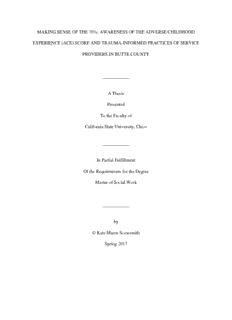
awareness of the adverse childhood experience (ace) score and trauma-informed practices of ... PDF
Preview awareness of the adverse childhood experience (ace) score and trauma-informed practices of ...
MAKING SENSE OF THE 70%: AWARENESS OF THE ADVERSE CHILDHOOD EXPERIENCE (ACE) SCORE AND TRAUMA-INFORMED PRACTICES OF SERVICE PROVIDERS IN BUTTE COUNTY ____________ A Thesis Presented To the Faculty of California State University, Chico ____________ In Partial Fulfillment Of the Requirements for the Degree Master of Social Work ____________ by © Kate Maren Scowsmith Spring 2017 MAKING SENSE OF THE 70%: AWARENESS OF THE ADVERSE CHILDHOOD EXPERIENCE (ACE) SCORE AND TRAUMA-INFORMED PRACTICES OF SERVICE PROVIDERS IN BUTTE COUNTY A Thesis by Kate Scowsmith Spring 2017 APPROVED BY THE INTERIM DEAN OF GRADUATE STUDIES: ________________________________ Sharon Barrios, Ph.D. APPROVED BY THE GRADUATE ADVISORY COMMITTEE: ________________________________ ________________________________ Dr. Jean Schuldberg, Ed.D. Patty Hunter, LCSW, MSW, Chair Graduate Coordinator ________________________________ Celeste Jones, Ph.D. ___________________________________________ Judy Vang, Ph.D. PUBLICATION RIGHTS No portion of this thesis may be reprinted or reproduced in any manner unacceptable to the usual copyright restrictions without the permission of the author. iii DEDICATION To all the resolute dreamers, thinkers, conceivers, organizers and believers that step outside their comfort zone for the betterment of others, communities, and the world. iv ACKNOWLEDGEMENTS I am forever humbled and amazed by the incredibly supportive community I have found at Chico State: my cohort, within the Social Work department, and those through my internship at Student Health Services. Without their unconditional support, hugs, and listening ears writing this thesis would not have been so substantial. I wish to thank my thesis committee: Patty Hunter, Chair, Dr. Celeste Jones, and Dr. Judy Vang. I extend my warmest regard and gratitude for your expertise, encouragement, and humor throughout this journey. In addition, I also wish to recognize the brilliant support of Dr. Susan Roll and Dr. Sue Steiner. I am thankful for each one of these instructors and members of my committee who have been incredibly generous with their time, wisdom, compassion, and skill in offering an enriching, approachable educational experience. My gratitude extends to Dr. Deborah Stewart and Lauri Evans at CSUC Student Health Services. Both Deborah and Lauri have been a tremendous source of knowledge and support during my internship and have been thoroughly receptive to hearing out and considering my ideas. Dr. Stewart has afforded me numerous opportunities for my personal and professional growth; her encouragement has been invaluable and has made me feel brave. Lauri has always had an open door and heart throughout the year; I cannot thank her enough for her advice and understanding. It has been inspiring to work with Deborah and Lauri, and bear witness to their commitment and contributions towards a thriving, healthy campus culture. Immense gratitude to my parents, Greg and Ann, and my sister, Hannah: for nurturing and cultivating my interests, encouraging my creativity, and wanting me to succeed...also, the laughs and the spontaneous excursions. Thanks to my grandparents for enriching my life in all v their unique ways, and especially to my grandmothers, Millicent and Geraldine, for exemplifying the exciting possibilities of being strong women. Lastly, love and appreciation to Julie Scalet and the entire Scalet family for the best of times and hanging through the worst of times. Our friendship has been a consistent source of joy, compassion and support that have helped make this thesis possible. Thank you for being you. vi TABLE OF CONTENTS PAGE Publication Rights ....................................................................................................... iii Dedication ................................................................................................................... iv Acknowledgments....................................................................................................... v List of Tables .............................................................................................................. x Abstract ....................................................................................................................... xiii CHAPTER PAGE I. Introduction ............................................................................................... 1 Background ................................................................................... 1 ix Statement of the Problem .............................................................. 4 Purpose of the Study ..................................................................... 5 Definition of Terms....................................................................... 6 II. Literature Review...................................................................................... 9 Introduction ................................................................................... 9 Trauma in the United States ...................................................................... 9 Adverse Childhood Experiences Study ........................................ 10 Medical and Health Challenges .................................................... 11 Social and Emotional Challenges ................................................. 13 Cognition and Neurodevelopment ................................................ 13 Vulnerable Populations ................................................................. 16 Lasting Impacts of Trauma ........................................................... 19 Interventions for Trauma .............................................................. 21 ACEs, Trauma and Butte County ................................................. 23 Theoretical Bases and Organization ............................................. 24 III. Methodology ............................................................................................. 27 Research Design............................................................................ 28 Selection of Survey Participants ................................................... 29 Instrumentation ............................................................................. 29 Data Analysis ................................................................................ 30 Limitations .................................................................................... 24 x IV. Findings and Results ................................................................................. 34 Introduction ................................................................................... 34 Quantitative ................................................................................... 36 Qualitative ..................................................................................... 36 Themes .......................................................................................... 46 V. Discussion ................................................................................................ 34 Quantitative ................................................................................... 34 One-Way Analysis of Variance (ANOVA) .................................. 36 Qualitative ..................................................................................... 36 VI. Conclusions and Recommendations ......................................................... 49 Conclusion .................................................................................... 49 Recommendations ......................................................................... 50 Implications for Social Work ........................................................ 52 References ..................................................................................................................... 54 Appendices A. ACEs Pyramid .......................................................................................... 71 B. Trauma-Informed Integrated Care ............................................................ 73 x C. Survey Instrument ..................................................................................... 75 D. Research Questions ................................................................................... 79 E. Trauma-Informed Practice: Approaches and Values............................................................................. 81 x
Description: